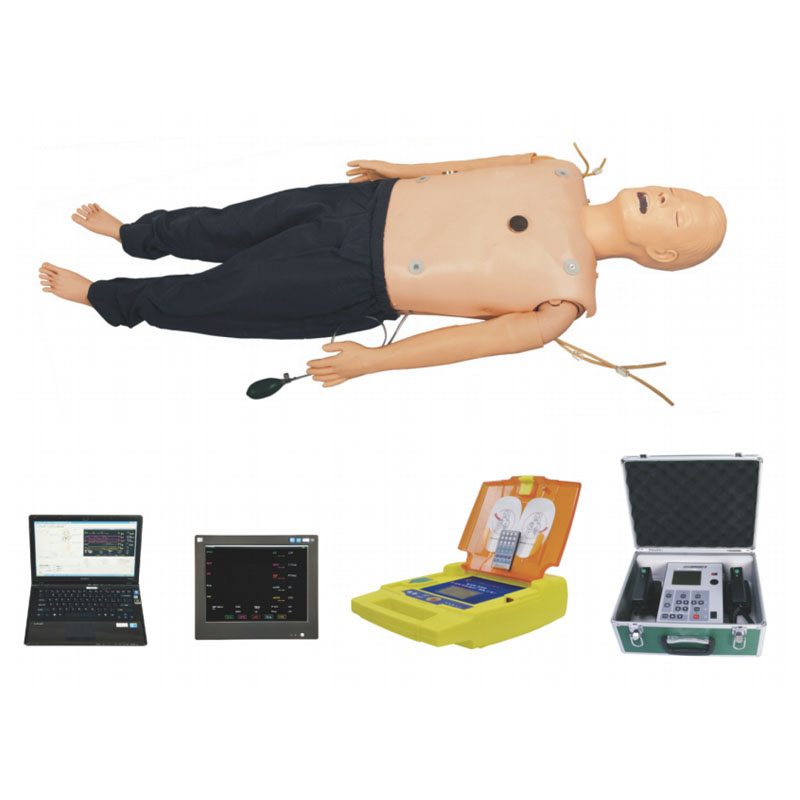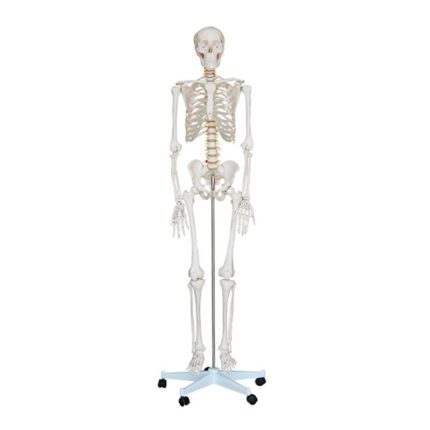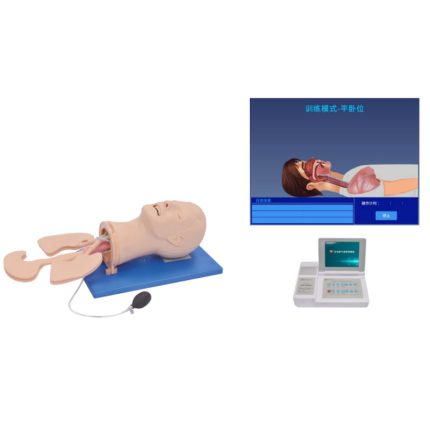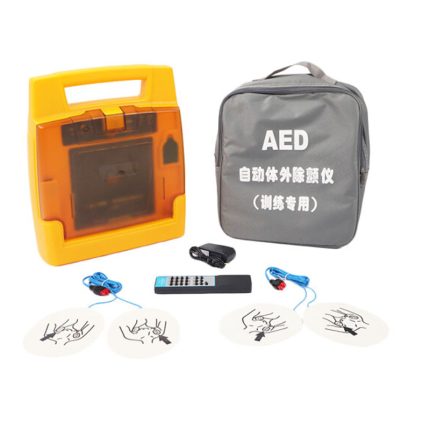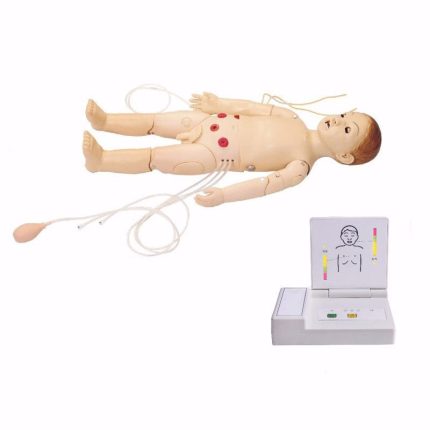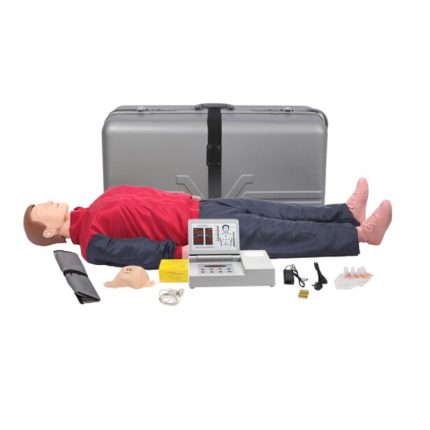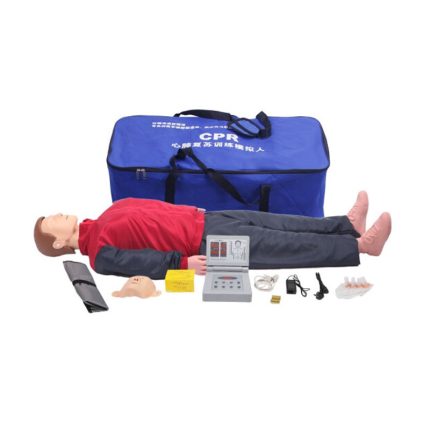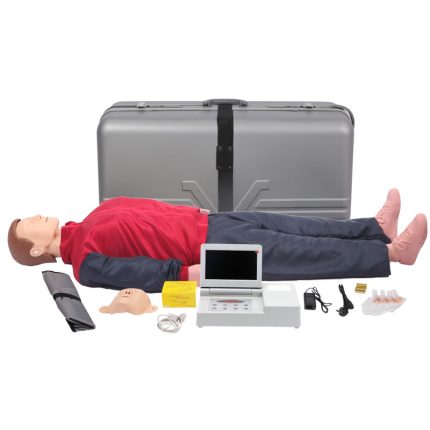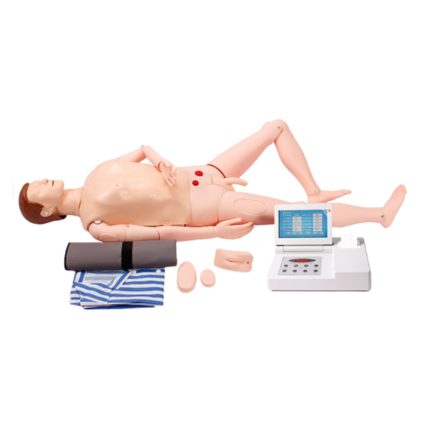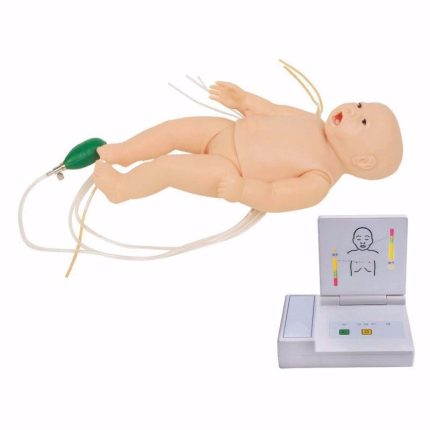Executive Standard: American Heart Association (AHA) 2020 Guidelines for International Cardiopulmonary Resuscitation (CPR)&Cardiovascular First Aid (ECC)
Features:
★ Symbols indicate functions that require optional accessories.
■ Head and Neck:
· Vital Sign Simulation: Pupil observation. The pupil LCD displays CSTN pseudo-color, 65k colors, and RGB. The pupil size can be adjusted from 1-7mm to normal, dilated, or constricted. The carotid artery can be vividly reproduced to simulate the patient’s groaning, coughing, and vomiting.
· Breathing Modes: Simulates normal breathing, sigh-like breathing, Cheyne-Stokes breathing, Kushmer breathing, and Biot breathing.
· Airway Management Techniques: Standard oral and nasal intubation, tracheotomy, and support for head tilt, chin lift, and jaw thrust techniques for airway opening. Tooth pressure alarm
★ Multimedia animations simultaneously display intubation position, and auscultation can be used to detect intubation position.
■ Chest and Abdomen:
· CPR Operation Training: Supports mouth-to-mouth, mouth-to-nose, simple respirator-to-mouth, and various ventilation methods. Electronic monitoring of airway patency, number of breaths, breath rate, breath volume, number of compressions, compression rate, compression location, and compression depth. Automatic determination of the ratio of artificial respiration to chest compressions. Real-time data displays that after a successful rescue, the simulator’s pupils return from dilated to normal, the carotid artery pulses, and spontaneous breathing occurs.
★ Realistic Defibrillation and Pacing: Compatible with defibrillators and pacemakers from different manufacturers and models to achieve realistic defibrillation and pacing.
★ Simulated Defibrillation and Pacing: Multimedia animations demonstrate the operation of a medical defibrillator. Used with the KAR/J980 simulated defibrillator and pacemaker, it can achieve defibrillation and pacing. Selectable defibrillation energy, with a maximum defibrillation energy of 360J.
★ Real AED: Compatible with AEDs from various manufacturers and models for realistic AED training.
★ Simulated AED: Multimedia animation demonstrates AED operation. Used with the SA/AED98F automated external defibrillator simulator for AED training. Fully voice prompts in Chinese are provided. Both patch electrodes and button electrodes are provided. The system automatically detects heart rate and analyzes whether defibrillation is necessary.
★ Real ECG Monitoring: Compatible with ECG monitors from various manufacturers and models for realistic ECG monitoring.
★ Simulated ECG Monitoring: Uses a fingertip-type blood oxygen sensor to monitor blood oxygen. Compatible with the KAR/J116 multi-parameter simulated ECG monitor for simulated ECG monitoring. Internal storage for over 2,500 ECG patterns. The multi-parameter simulated monitor’s LCD screen provides 12-lead electrocardiogram, blood oxygen saturation, respiration, carbon dioxide, blood pressure (arterial pressure, central venous pressure, pulmonary artery pressure, non-invasive blood pressure), cardiac output, and more.
· Auscultation: Hundreds of sounds can be auscultated, including normal and abnormal heart sounds, normal and abnormal breath sounds, normal and abnormal bowel sounds, and more.
■ Limbs:
· Left-hand blood pressure measurement, bilateral superficial vein infusion/puncture on the dorsal hand, and bilateral intramuscular injection. The arm veins are highly realistic and feel realistic, with a distinct, drop-off sensation and blood return when the puncture is performed correctly. The skin and blood vessels are interchangeable.
· The simulator’s male and female external genitalia are interchangeable, allowing for catheterization training and intramuscular injection training in the vastus lateralis of both thighs.
· The simulator’s ankle joint can rotate left and right.
■ Software:
· Syringe/infusion pump operation simulation: Multimedia animation demonstrates the syringe/infusion pump operation process, with the option to select a medication for operation.
· Training and Assessment: The software contains hundreds of test questions, including ECG, first aid theory, first aid scenarios, case studies, and CPR training and assessment. Teachers can also add test questions based on the course content.
· First aid scenario script training/assessment: The software includes dozens of first aid scenarios, covering heart disease emergency cases such as ventricular fibrillation/pulseless ventricular tachycardia, pulseless cardiac activity, ventricular arrest, acute coronary syndrome, bradycardia, unstable tachycardia, stable tachycardia, and acute stroke. These scenarios help physicians understand and master clinical first aid procedures for various heart disease types.
· Provides a variety of medications and typical ancillary examinations, including chest X-rays, echocardiograms, and 12-lead ECGs.
· Script/Case Editor: The software provides a variety of common cases and rich multimedia animations to vividly recreate real-life first aid scenarios. Users can edit emergency cases, including patient condition changes and student operation progress, which are automatically recorded by the software.
· Local area network teaching: For group teaching, self-study, practice, and assessment, the teacher’s computer can monitor the operating status of all student computers.
· Available in stand-alone (one point, one system) and network (one point, multiple systems). The stand-alone version can be upgraded to the network version.
Basic Configuration:
■ Hardware:
· ACLS High-Intelligence Adult Simulator
· SA/S7G Blood Pressure Measurement Trainer, Electronic Simulator Stethoscope
· Simple Respirator, Stethoscope, Laryngoscope, Tracheal Tube, Infusion Set
■ Software:
· LAN Teacher Computer Application Software V2.0
· LAN Student Computer Application Software V2.0
· ACLS Script Editor Software V2.0

